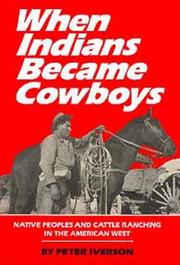Check nearby libraries
Buy this book

In this book on Indian cattle ranching, Peter Iverson describes a way of life that has been both economically viable and socially and culturally rewarding. Thus an Indian rancher can demonstrate his generosity and his concern for the well-being of others by giving cattle or beef to relatives, or by feeding people at a celebration. An expert rider possesses a skill appreciated by others.
A rancher who raises prime cattle demonstrates that Indians can compete in an activity that dominates the surrounding non-Indian society.
Focusing on the northern plains and the Southwest, Iverson traces the rise and fall of individual and tribal cattle industries against the backdrop of changing federal Indian policies. He describes the Indian Bureau's inability to recognize that most nineteenth-century reservations were better suited to ranching than farming. Even though allotment and leasing stifled ranching, livestock became symbols and ranching a new means of resisting, adapting, and living - for remaining Native.
In the twentieth century, allotment, leasing, non-Indian competition, and a changing regional economy have limited the long-term economic success of Indian ranching.
Although the New Deal era saw some marked improvements in Native ranching operations, Iverson suggests that since the 1960s, Indian and non-Indian ranchers alike have faced the same dilemma that confronted Indians in the nineteenth century: they are surrounded by a society that does not understand them and has different priorities for their land.
Cattle ranching is no more likely to disappear than are the Indian communities themselves, but cowboys and Indians, who share a common sense of place and tradition, also share an uncertain future.
Check nearby libraries
Buy this book

Previews available in: English
| Edition | Availability |
|---|---|
|
1
When Indians Became Cowboys: Native Peoples and Cattle Ranching in the American West
September 1997, University of Oklahoma Press
Paperback
in English
0806128844 9780806128849
|
zzzz
Libraries near you:
WorldCat
|
|
2
When Indians Became Cowboys: Native Peoples and Cattle Ranching in the American West
1994, University of Oklahoma Press
in English
0585169322 9780585169323
|
zzzz
Libraries near you:
WorldCat
|
|
3
When Indians became cowboys: native peoples and cattle ranching in the American West
1994, University of Oklahoma Press
in English
0806118679 9780806118673
|
aaaa
Libraries near you:
WorldCat
|
Book Details
Edition Notes
Includes bibliographical references (p. 225-255) and index.
Classifications
The Physical Object
ID Numbers
Source records
Scriblio MARC recordLibrary of Congress MARC record
Internet Archive item record
marc_openlibraries_sanfranciscopubliclibrary MARC record
Library of Congress MARC record
Better World Books record
marc_columbia MARC record
First Sentence
"THE CATTLE CAME FROM ELSEWHERE."
Community Reviews (0)
Feedback?| July 18, 2024 | Edited by MARC Bot | import existing book |
| August 16, 2020 | Edited by ImportBot | import existing book |
| February 13, 2020 | Edited by MARC Bot | remove fake subjects |
| July 22, 2017 | Edited by Mek | adding subject: In library |
| December 9, 2009 | Created by WorkBot | add works page |













